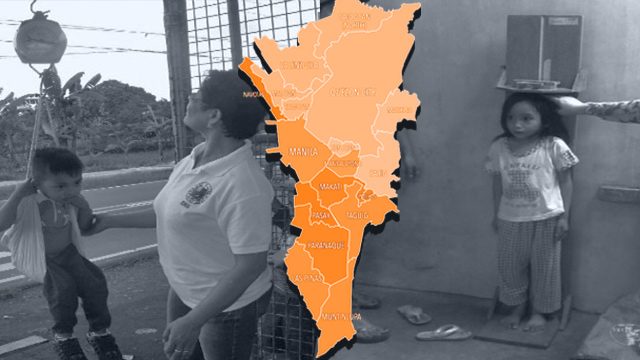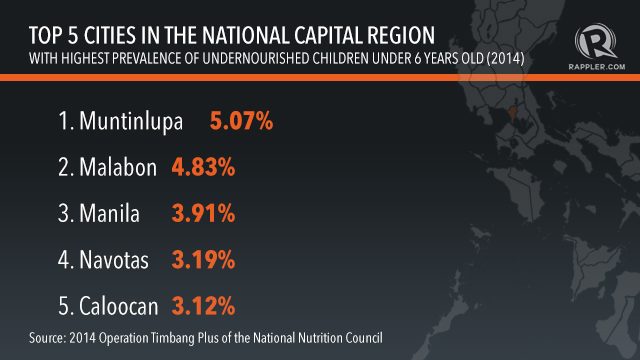SUMMARY
This is AI generated summarization, which may have errors. For context, always refer to the full article.

MANILA, Philippines – What’s the malnutrition situation in the National Capital Region (NCR)?
The 8th National Nutrition Survey (NNS) of the Food and Nutrition Research Institute (FNRI) found out that the most populous region in the Philippines is faring well compared to other regions.
Out of the 17 regions, NCR is last when it comes to undernourishment. Almost 13% of children under 5 years old in the region are underweight. This is below the country average of 19.9%.
However, like other regions and the nation as whole, NCR suffers from double burden malnutrition. (READ: Too little, too much: The problem with double burden malnutrition)
Results of the 2014 Operation Timbang (OTP) Plus of the 16 cities and one municipality in Metro Manila show that despite the fairly all right situation, there has been little change.
OTP is the annual weighing of pre-schoolers below 6 years old (or 0 to 71 months old) in different communities. The program, spearheaded by the National Nutrition Council (NNC), aims to identify and locate malnourished children for local nutritional planning. (READ: Who are your barangay nutrition scholars?)
What are the top 5 NCR cities with malnourished children based on data collated by Barangay Nutrition Scholars (BNS)?

Out of the 5 cities, 3 have been on the list for 3 consecutive years already: Malabon, Muntinlupa, and Manila.
From 2012 to 2013, Malabon took the second spot before leading the group in 2014. Meanwhile, Muntinlupa and Manila have remained on the list from 2013 to 2014.
| RANK | 2012 | 2013 | 2014 |
| 1 | San Juan | San Juan | Muntinlupa |
| 2 | Malabon | Malabon | Malabon |
| 3 | Pasay | Muntinlupa | Manila |
| 4 | Navotas | Pasay | Navotas |
| 5 | Pasig | Manila | Caloocan |
Previous high-ranking members such as Pasay, Pasig, and San Juan successfully decreased the prevalence of undernutrition in their areas in the span of 3 years.
Pasig was able to get the 12th spot in 2014 after being the 5th in 2012 and 6th in 2013. Pasay, from improving 2012’s 3rd to 2013’s 4th, jumped 4 spots to 8th in 2014.
Meanwhile, San Juan, which led the list from 2012 to 2013, jumped to the 6th spot in 2014.
Focus on first 1,000 days
The NNC emphasized the need for nutrition programs to focus on the first 1,000 days of a child as data show the increasing trend of undernutrition among children aged 0 to 35 months.
The first thousand days are considered the “window of opportunity” for intervention and seen as very crucial in determining the track of a child’s health. If the lack of proper nutrition is not addressed during this period, irreversible effects can taint a child’s life.
This can be prevented in many ways. Exclusive breastfeeding up to 6 months can ensure the mother’s health while pregnant, and prevent malnutrition, as essential nutrients are passed from the mother to the child. (READ: The real cost of infant milk formula)
Hunger and malnutrition are the world’s most solvable problems. If eliminated, the benefits can go beyond the people suffering from them and positively affect the economy as well. (READ: What happens when we end hunger and malnutrition) – Rappler.com
Add a comment
How does this make you feel?
There are no comments yet. Add your comment to start the conversation.